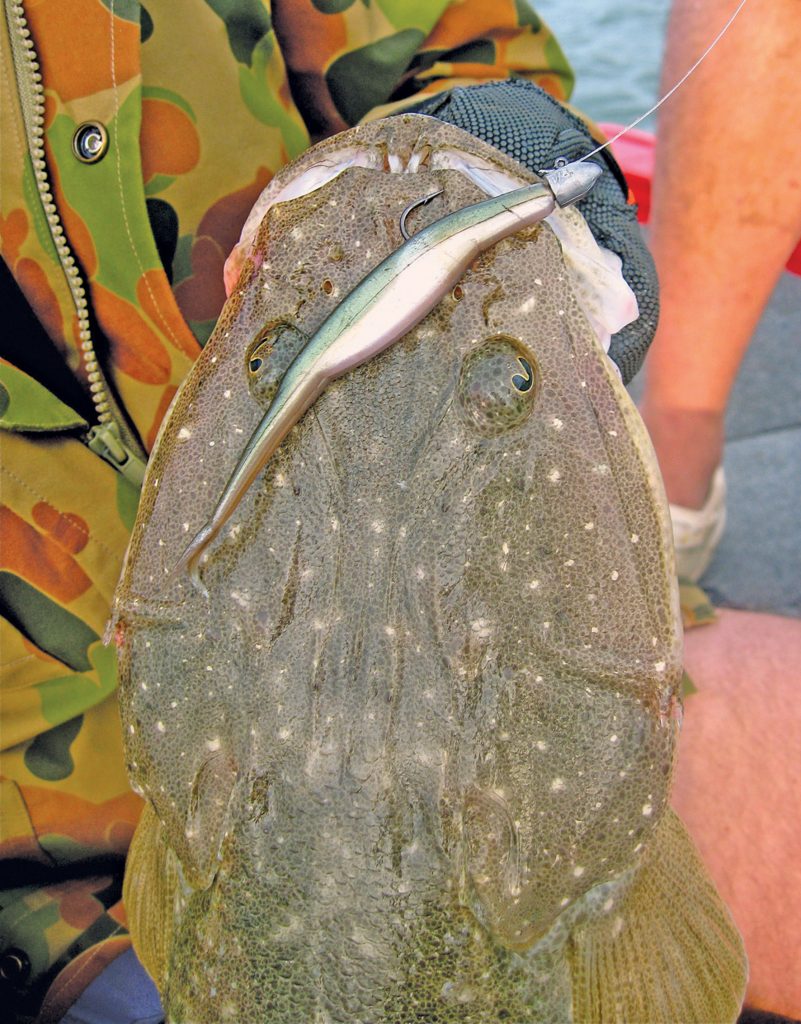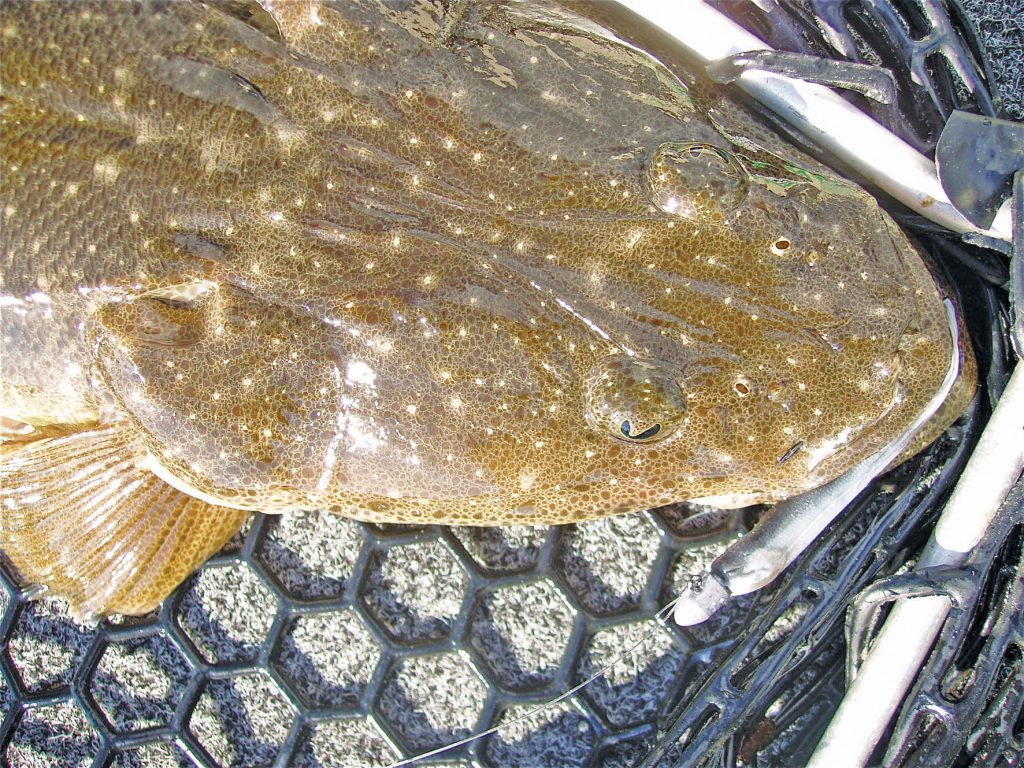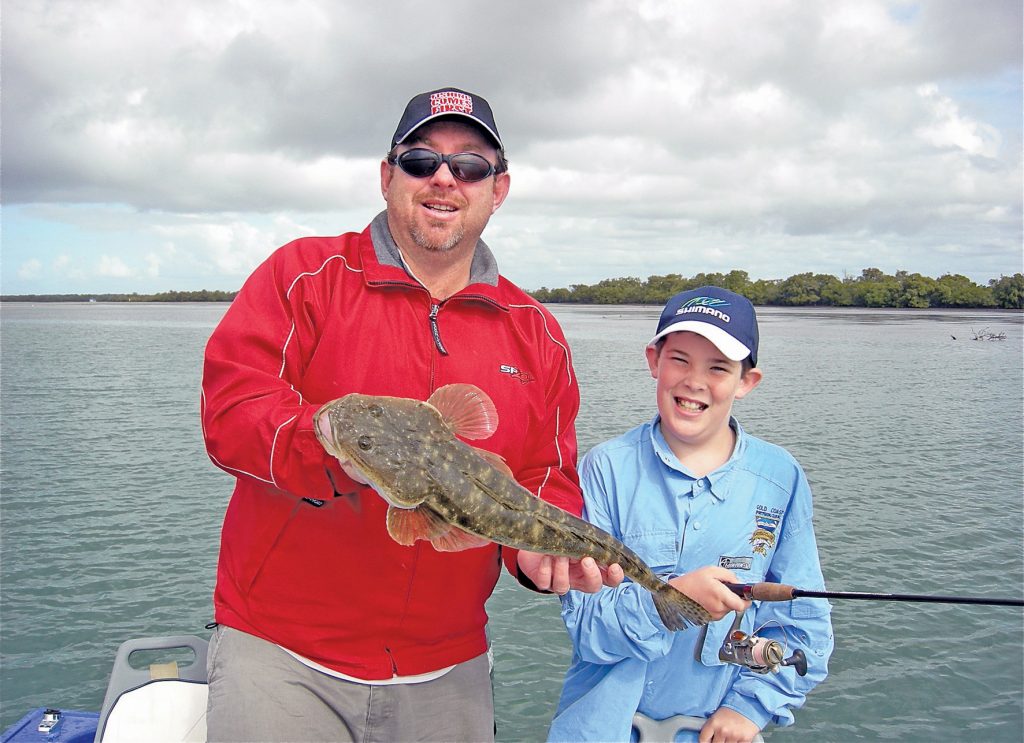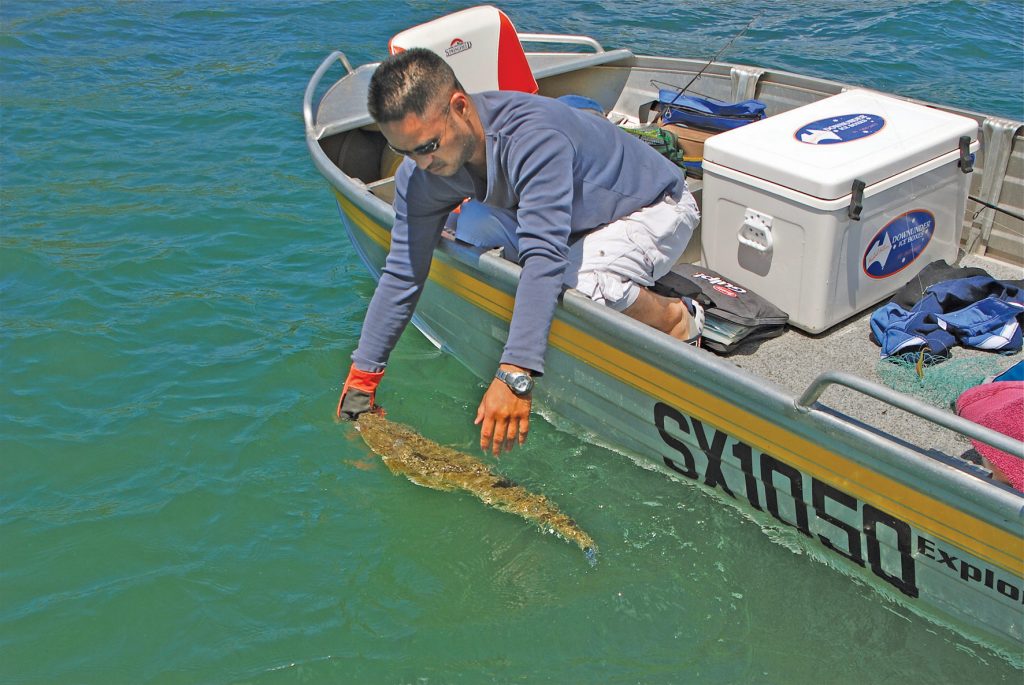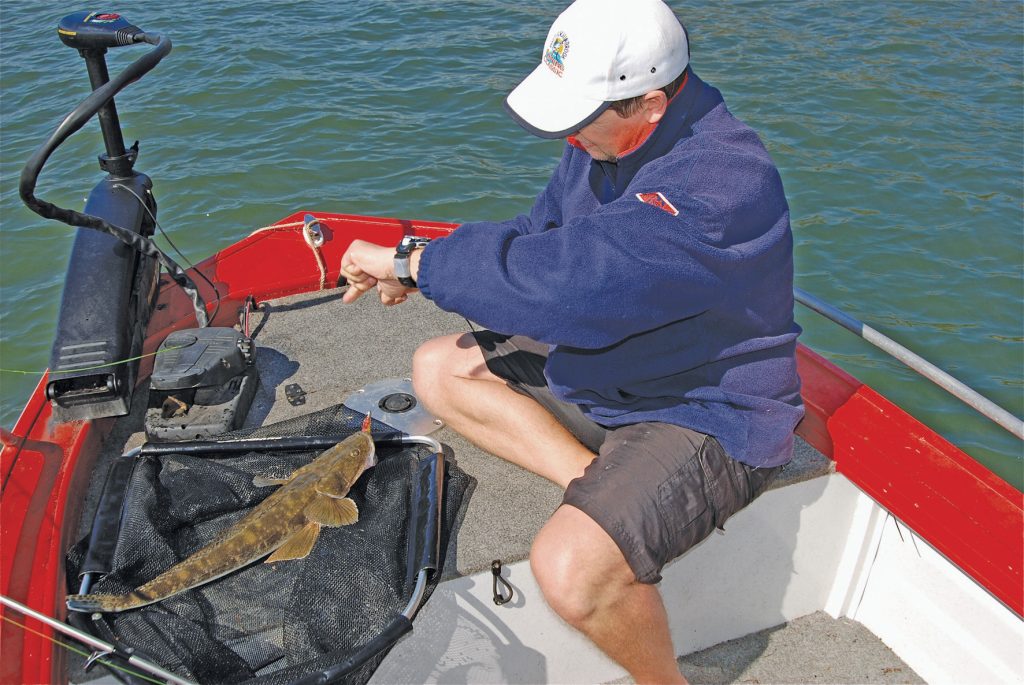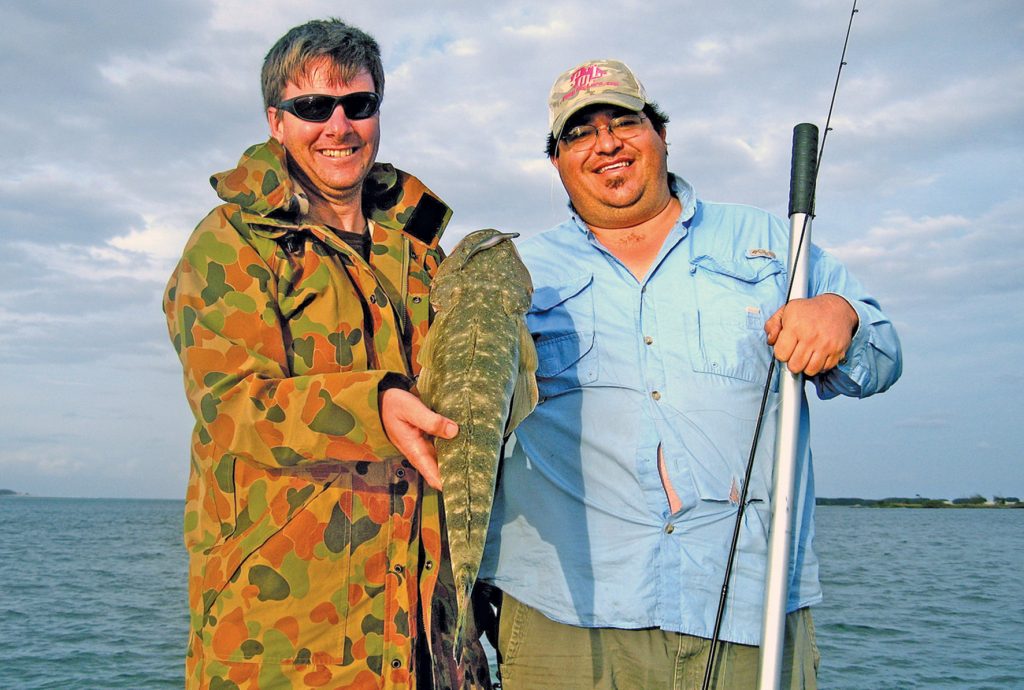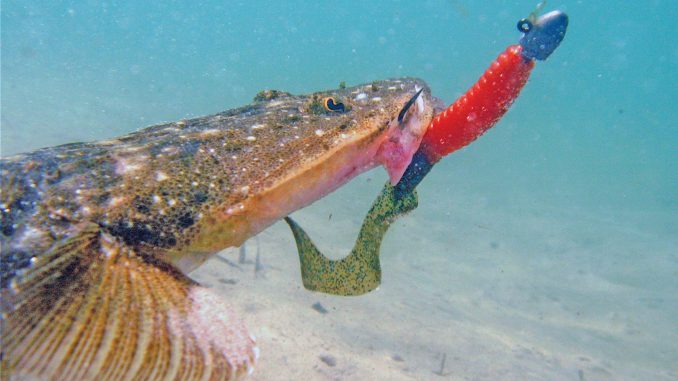
by Shayne McKee •
We’re going to talk about why low water is such a good time to target flatties with plastics, what to look for and where to cast, what I use and find important to success and also look at the basic retrieve.
Low tide is the perfect time to cast and retrieve plastics for flathead for a number of reasons. Not the most important point, but certainly worth noting for those new to casting for flathead is that you can usually see your target. The targets at low tide revolve around structure; weed beds, snags, rocky areas, hard black clay and even drop offs. Being able to define your target area makes everything else we’ll talk about seem much more sensible, and if you know me, you’ll understand being sensible is very hard for me.
If you check over this map, you’ll see a variety of situations where flathead will be found in and around low tide.
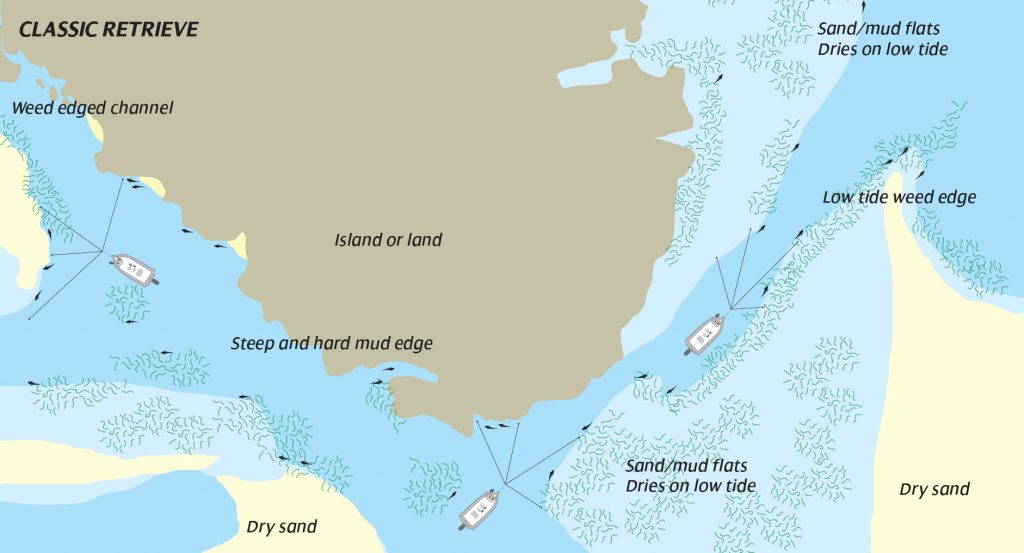
The pick for me is the weedy edges. These weed edges usually run along the typical low tide height and provide cover and food; two very important factors wherever you want to chase flathead. As you can see the weed edge clearly, it’s a simple matter of casting to it and then working your lure out from the edge. The idea here is to imitate a baitfish being forced out of the weed to the relative sanctuary of deeper water. And don’t be afraid to cast really tight to the weed as the flathead will lie with just their eyes visible right alongside and sometime actually in the weed.
The next feature is the hard clay or dark soil edge you can find in almost any estuary. These edges are usually quite steep, some even being sheer sided. These edges are actively eroding and little clumps of hard clay or mud can be found right along the edges of the steep bank. The flathead love this territory as the irregularly shaped and scattered, darker clumps provide fantastic camouflage for the flatty. There is also some talk around the traps that the darker muds and clays warm up a little more and provide a little bit more warmth for the fish. Not sure if this is true, but the flathead do love sitting here.
Draining channels are an old favourite. From small to large, any channels that drain off an extensive sand or mud flat is a great place to find a flatty or three. These drains are so good because they are highways for the baitfish to escape the receding water. The old flatty is onto this and sits on the edge of the draining water or on the first drop-off, just waiting for its dinner to come straight to it. Simple and effective and no energy wasted by the flatty getting a feed.
THE RETRIEVE
Given there are numerous areas to fish at low tide and that you’ve found them, the next piece of the puzzle is delivering the plastic to the fish in a way that makes it want to eat it.
I use one standard retrieve and vary it from day to day, even from hour to hour. This retrieve is the most basic thing to get right as most of the jerkbait-style plastics we use need to be worked hard to get the best from them.
The basic retrieve involves letting the lure come to rest on the bottom, then quickly jerking the rod tip upwards twice. As the lure falls back to the bottom wind up the slack. This is repeated all the way back to the boat. The jerk of the rod tip is usually a quite violent jerk, however this is where you can experiment a little. On some days the jerk can be more mild, others more aggressive; you just have to read the mood of the fish and the situation you are in.
Another alteration you can make is the number of jerks. I generally do two, but in really shallow water one jerk may be enough. Conversely in slightly deeper water, three jerks may be used.
But regardless of the number of jerks used or the strength of the jerk, it is vitally important to keep tight to the lure on the fall as the flathead usually snaffles your offering on the drop. You can tell a fish has attacked your lure by feeling and seeing a peck on the line. We call this a tick or a tonk – the tick for small fish and the tonk for the bigger fish. After a few hundred hits you’ll soon get an appreciation of the difference and be a bit more prepared for what swims out of the depths.

SOME FAVOURITES
Lures are lures, right? Hard one to answer, as all lures will catch a flathead but some do it better than others. I have my favourites and I reserve the right to add or delete favourites as new plastics hit the market.
As it is in 2011, my favourite soft plastics include the 4” Old Bayside Shadlyn, 5” Mr Twister Exude RT Minnow, 4” or 5” Gulp Jerkshads, Z-Man Streakz and Berkley 4” Power Minnows.
Each of these lures has the ability to be worked hard, jerk to one side and glide back to the bottom. I don’t want to have too much action in the lure itself and rely on rod work to impart most of the action.
As far as colours go, we have caught flatties on all of them, from bright pink to clear with gold sparkles, from black to white – they all work at some time. However, and there is always a however, my preferred colours include avocado green, red and gold, natural minnow patterns and browns (also known as crawdad).
If you were limited to what you could buy, stick with these colours as most of the time you’re fishing relatively clear water where the flatties are hunting by sight.
I also have a preference for a 3/8oz jighead with a 5/0 hook. This weight will fish well in 30cm of water down to 4m and the 5/0 hook is the ideal match for a 5” plastic. The only alteration I make is to downsize the hook to a 4/0 (sometimes a 3/0) when I drop back to a 4” plastic.
Since their release I’ve used TT Lures jigheads, but I have also used Berkley Nitro heads, Dikheads (a local Queensland manufacturer), Gamakatsu heads and PML heads. All work well; just make sure the hooks are as sharp as you can make them. If it’s not sharp, tie on a new jighead.
THE OUTFIT
I am pretty specific about what I think makes a good plastics rod for flathead and it all comes down to being able to work the lure, then being able to drive the hook point into the fish’s mouth.
The reel is the least important. All it does is hold the line. I use a 1500 or 2000 size reel and load it up with 4lb to 6lb braided line. I have been using Fireline Crystal lately and found it to be great, but I also use HiSeas Grand Slam 6lb and really like this line because it’s braided and casts effortlessly day in and day out.
I’ll be checking out the Berkley Nanofil this year, too, and look forward to seeing how that goes as it is incredibly thin and feels different in the hand from most other superlines.
The leader is very important – flatties can chew through leaders easily. I am in love with 16lb Sunline FC Rock. This is tough, holds knots well and has not let me down yet.
The rod I use is an L.Wilson Blades ’n’ Tails Light. This rod has a light tip and is rated to 3kg. The light tip allows the rod to really rip the lure when you jig it and the strong butt lets me sink hooks easily. And on that note, strike hard at every fish to ensure the hook is set. The number of anglers who drop fish beside the boat is directly related to the number of anglers who do not strike hard or use a soft rod.
I also use a relatively heavy drag to help set the hook and will happily loosen the drag off if a big fish is hooked. I’ll say it again – sink the hook hard!
LITTLE EXTRAS
Over the course of your flathead fishing you’ll come across a range of products that simply make the day that little bit easier. For me there are a few things you should seriously consider investing your hard-earned on.
My top five extras include the revolutionary Minn Kota iPilot, the Lindy Fish Handling Glove, the magical Environet, a set of long-nosed pliers and a good set of polarised sunnies.
The iPilot allows you unparalleled control over your boat position and will catch you more fish.
The Fish Handling Glove from Lindy will stop flathead tearing at your thumbs and reduce the incidence of spiked hands as well.
The Environet is a must if you plan to release some fish; it treats them very well. The big tip here is make sure you buy the biggest available. Everyone laughs at the one we use until they see an 80cm flatty slide into it – just!
Long-nosed pliers are a must for removing hooks easily. These keep fingers away from teeth, hooks and spikes.
And good polarised sunnies ensure you can see what you need to, whether that’s casting targets, baitfish or simply water depth.
GET INTO IT
Hopefully that will help you all catch a few more flathead next time you hit the water. Flatties are not particularly smart, they are abundant and relatively easy to catch. For all these reasons, you really need to remember the legal limits and stick to them. I don’t begrudge anyone having a feed of flatties as they are magnificent to eat, but don’t go out and smash them to bits.
We have a self-imposed limit of five fish between 50cm and 65cm on my boat and this limit is not difficult to obtain in a session.

